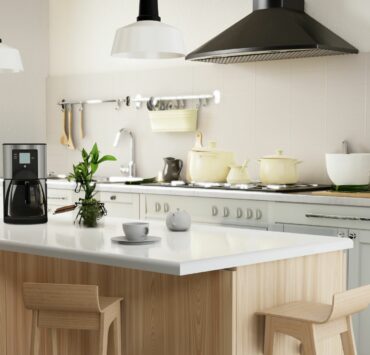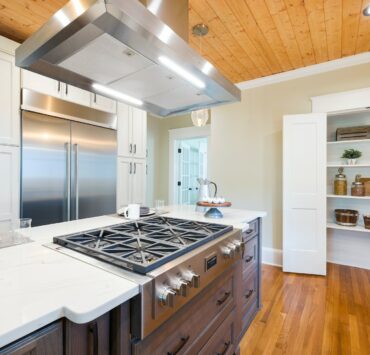If you’re looking forward to changing your kitchen sink and are unsure how to choose, read our guide on choosing a kitchen sink.
Whether you realize it or not, a kitchen sink is a central piece in your home, considering that you use it every day, multiple times a day. For a space you’re going to spend a significant time daily, you may as well fully embrace it by elevating it on a visual and functional level to create a space where you find joy in using it.
If you’re looking to upgrade your sink, here are some key things to consider:
Kitchen Sink Sizes
Knowing how large you want and need your kitchen sink is the first step when choosing a kitchen sink. Please take a moment to assess the daily activity in your kitchen, how frequently the sink comes into use, and how many items you have that will be washed in it.
Washing, of course, is a primary use for a sink, so knowing how often you wash and what you wash will help determine how large your sink will be. Larger families, for instance, will need a bigger and deeper sink to accommodate a large volume of dishes and items such as large pots and pans.
A large sink may not be necessary if you have a dishwashing machine. You also need to know if your countertop can accommodate your desired sink size.
How to Measure Kitchen Sink
The size of your kitchen sink is measured in accordance with the counter depth. For obvious reasons, you need the sink to fit within the counters dimensions for proper sink installation. Make sure you take into account the overhang of the sink lip as this is technically the sink length regardless of the size of the basin.
To get a good idea of the type of sink your countertop can accommodate, measure your current sink starting with the sink length along with the basin length and and basin depth. Check as well for the location of the pipes under the sink because you will need them to align or be able to connect with the kitchen drain.
Types Of Kitchen Sinks
Bar Sink
A bar sink, also known as a prep sink, serves as a secondary sink usually installed into a kitchen island. It’s smaller, narrower and shallower and its purpose is more for cleaning up things such as glassware and other items needed to prepare drinks .
Corner Kitchen Sink
A corner kitchen sink is a two-basin sink installed into the corners of a countertop to save space, making it a good option to maximize space within a small kitchen.
Drop-In Sink
Drop-In sinks are perhaps the easiest to install and are DIY-friendly, which makes sense why they are the most common type of kitchen sink. They have slightly raised and rounded edges that hinder water and debris from spilling out of the sink. After cutting out a hole on your countertop, you essentially drop in the sink from above and secure it down with clips and screws, with the sink lips acting as the seal on the counter and support.
Farmhouse Sink
Farmhouse sinks are sturdy, and with that, installation requires a sturdy base for it to rest on. Farmhouse sinks distinctly have a deep and wide single basin that protrudes past the countertop’s front edge. Farmhouse sinks can come in different materials lending a different aesthetic for each type, such as:
- Stainless steel farmhouse sinks give a modern, sleek, industrial look to a kitchen. The stainless steel finish is usually its natural silver color. Still, you can opt for a black farmhouse sink which adds a moodier dimension to an already modern and sleek aesthetic.
- Copper farmhouse sinks stand the test of time when properly maintained and are naturally antibacterial. A copper sink can elevate the entire look of a kitchen thanks to its natural earthy-toned allure, which in time, turns into its own distinct shade of blue-green.
Flush Mount Kitchen Sink
A more seamless counterpart to drop-in sinks, flush mount sinks are installed and aligned to the level of a countertop. It features straight edges and gives a minimal yet streamlined look.
Integrated Kitchen Sink
Integrated sinks also provide a minimal and streamlined design, with their material being matched to the countertop and then shaped into it. When installing, a pocket is created, so the sink blends in with the counter.
Undermount Kitchen Sink
Undermount sinks are installed from below the counter and set in place with heavy-duty clips and adhesive. Undermount sinks are typically paired with countertops with a solid surface. Unlike a drop-in sink, undermount sinks don’t have a lip that rests on the countertop, making cleaning a countertop easy as you can sweep debris directly into the sink.
Should You Go With A Single Or Double Basin Kitchen Sink?
When choosing between a large single basin sink or a large sink divided into two basins, there are pros and cons to each, and it ultimately boils down to the preference of who will use it most.
Single basin sinks leave a lot of room for washing and are more aesthetically pleasing for those who prefer a clean and minimal look for an otherwise busy workspace. Single basin sinks, of course, are the better space-saving option in small kitchens. Even in large kitchen spaces, single basin sinks give a larger washing space which is ideal if you have large items to wash, such as sheet pans and large pots.
Double basin sinks work great in households that don’t have a dishwasher. A double basin sink creates an efficient division between dirty/soapy items and clean items for rinsing, which adds to the sense of a smoother flow of work. Unless you’ve got the counter space to accommodate a sizeable double-basin sink or even a triple basin sink, you need to weigh your preference between having ample washing space over designated washing spaces.
What is Best Kitchen Sink Material
Price, durability, aesthetics, and maintenance are all factors to consider when choosing the best kitchen sink material for your home. Some options include:
Cast Iron Sink
Cast iron sinks are as heavy as they are durable. Although prone to scratches and chipping from sharp or fallen objects, cast iron sinks last for years and can withstand heat.
Copper Kitchen Sink
As mentioned earlier, copper sinks are naturally antibacterial and ideal for keeping dirt and grime in your sink at a minimum. Copper in itself is a beautiful material to look at. Still, with time, the patina (the greenish and bluish coating) becomes more distinct and forms its unique pattern, which can be very appealing to homeowners.
Granite Composite Sink
A high-quality alternative to granite, granite composite sinks are non-porous, easy to clean and easy to maintain from damage such as scratches and discoloration.
Stainless Steel Sink
Stainless steel sinks are built to last and may be the most popular sink material option. Stainless steel sinks instantly give a kitchen a modern look, all while being durable and scratch resistant.
For whatever preferences you have for your sink, make it your own and choose the size, design, and material that will help you enjoy the daily chore of washing.
Related posts:
 Your Guide to the Best DIY Budget Kitchen Remodel Ideas
Your Guide to the Best DIY Budget Kitchen Remodel Ideas
 Outdated Kitchen Trends that You Must Stay Away From in 2022
Outdated Kitchen Trends that You Must Stay Away From in 2022
 Small Space, Big Style: A Guide to Mobile Home Kitchen Remodel
Small Space, Big Style: A Guide to Mobile Home Kitchen Remodel
 European Kitchen Cabinets: A Comprehensive Guide for Homeowners
European Kitchen Cabinets: A Comprehensive Guide for Homeowners
 How to Install Moen Kitchen Faucet: A Step-by-Step Guide
How to Install Moen Kitchen Faucet: A Step-by-Step Guide



